Bienvenue dans le monde de plaquettes en carbure polies! Si vous êtes ici, c'est que vous cherchez probablement à vous plonger dans les nuances de cet outil hautement spécialisé et pourtant essentiel. Que vous soyez un machiniste chevronné ou que vous débutiez, ce guide vous aidera à naviguer dans les détails complexes des plaquettes en carbure poli, depuis leurs types jusqu'à leurs applications, leurs propriétés et la manière de sélectionner celle qui convient le mieux à vos besoins.
Aperçu des plaquettes en carbure poli
Les plaquettes en carbure poli sont un élément essentiel de l'industrie manufacturière, principalement utilisé dans les opérations de coupe, d'usinage et de perçage. Ces plaquettes sont connues pour leur dureté exceptionnelle, leur résistance à l'usure et leur capacité à conserver une arête vive dans des conditions extrêmes. Les plaquettes en carbure polies sont fabriquées à partir d'un matériau composite, principalement du carbure de tungstène, auquel sont ajoutées d'autres poudres métalliques pour améliorer certaines propriétés.
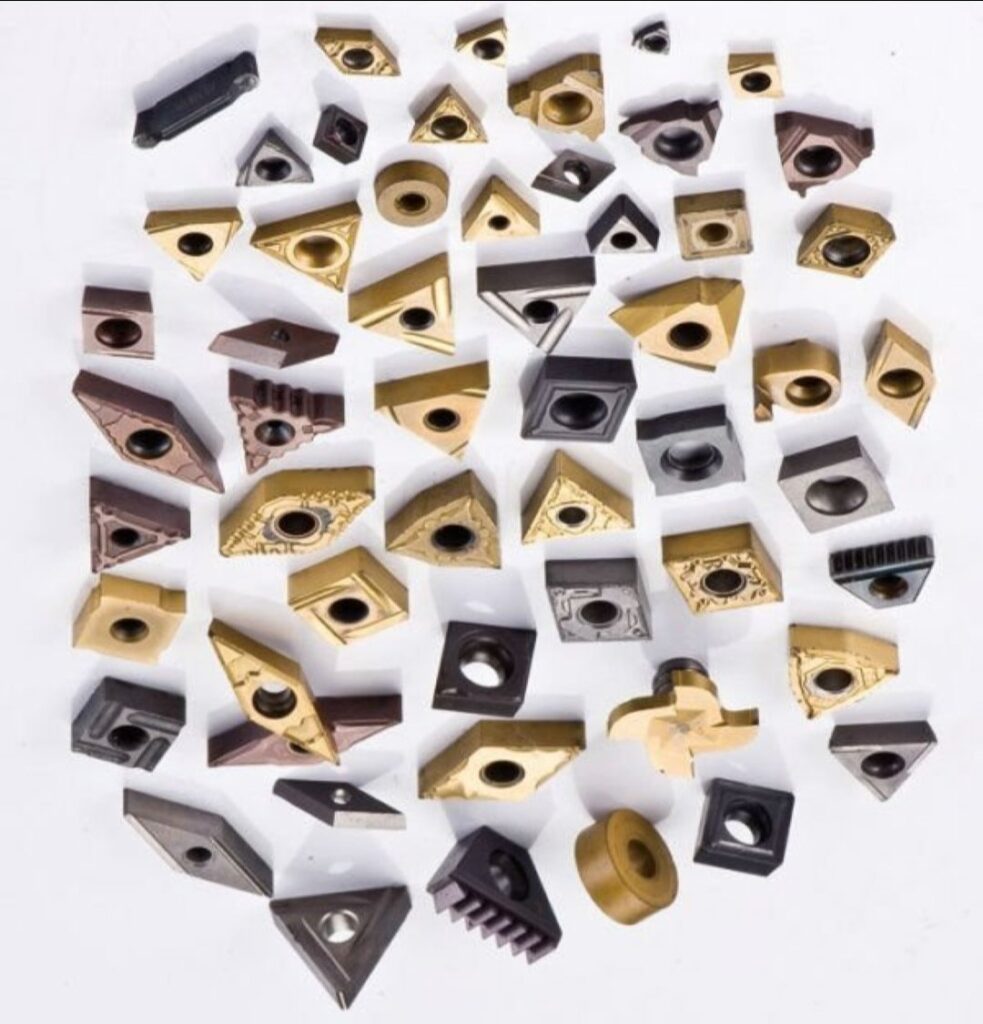
Types de plaquettes en carbure polies
Plaquettes en carbure polies se présentent sous différentes formes et tailles, chacune étant conçue pour un type d'opération d'usinage spécifique. Examinons de plus près les différents types de machines et leurs caractéristiques uniques.
| Type | Description |
|---|---|
| Plaquettes de tournage | Utilisé pour les opérations de tournage, disponible en différentes formes telles que carrée, triangulaire et rhomboïdale. |
| Plaquettes de fraisage | Conçues pour les applications de fraisage, ces plaquettes sont disponibles en formes rectangulaires et carrées. |
| Plaquettes de forage | Spécialement conçus pour les opérations de forage, ils sont généralement cylindriques ou en forme de balle. |
| Plaquettes de rainurage | Utilisé pour créer des rainures et des découpes, souvent de forme rectangulaire ou arrondie. |
| Inserts de filetage | Conçus pour les opérations de filetage, ils sont généralement triangulaires avec des pointes acérées. |
| Plaquettes d'alésage | Conçus pour les opérations d'alésage, ils sont souvent de forme cylindrique ou ronde. |
| Plaquettes de séparation | Utilisé pour séparer ou couper des matériaux, généralement étroits et rectangulaires. |
| Plaquettes de profilage | Conçus pour la réalisation de contours et de profils, ils sont disponibles en différentes formes. |
| Plaquettes de surfaçage | Utilisé pour les opérations de surfaçage, souvent carrées ou rondes. |
| Plaquettes de chanfreinage | Spécialement conçu pour le chanfreinage, généralement en forme de diamant ou de triangle. |
Applications des plaquettes en carbure poli
Les plaquettes en carbure poli sont utilisées dans un large éventail d'applications en raison de leur polyvalence et de leur durabilité. Voici quelques applications courantes :
| Application | Description |
|---|---|
| Industrie automobile | Utilisé pour l'usinage de pièces de moteur, de composants de transmission et d'autres pièces automobiles critiques. |
| Industrie aérospatiale | Indispensable pour la fabrication de composants de haute précision tels que les pales de turbines et les structures d'avions. |
| Fabrication de dispositifs médicaux | Utilisé dans la production d'instruments chirurgicaux et d'implants. |
| Industrie du pétrole et du gaz | Vital pour le forage et l'usinage des pièces utilisées dans les équipements d'exploration et d'extraction. |
| Travail des métaux | Employé dans les processus généraux de coupe, de façonnage et de formation des métaux. |
| Fabrication d'outils et de matrices | Crucial pour la création de moules, de matrices et d'autres outils de précision. |
| Travail du bois | Utilisé pour couper et façonner les matériaux en bois. |
| Usinage des matières plastiques et composites | Utilisé pour l'usinage des matériaux plastiques et composites dans diverses industries. |
| Fabrication de bijoux | Employé pour la coupe et le façonnage précis des métaux précieux et des pierres. |
| Fabrication de machines lourdes | Essentiel pour l'usinage de composants lourds et de grande taille pour les machines industrielles. |
Propriétés des matériaux des plaquettes en carbure polies
Comprendre les propriétés des matériaux plaquettes en carbure polies est cruciale pour sélectionner le bon type de produit pour votre application. Voici un aperçu détaillé de leurs propriétés :
| Propriété | Description |
|---|---|
| Dureté | Dureté exceptionnelle, généralement comprise entre 85 et 92 HRA. |
| Solidité | Haute ténacité, leur permettant de résister à des contraintes et à des impacts importants. |
| Résistance à l'usure | Résistance supérieure à l'usure, prolongeant la durée de vie de l'outil et préservant son tranchant. |
| Stabilité thermique | Excellente stabilité thermique, capable de fonctionner à des températures élevées sans se dégrader. |
| Résistance chimique | Haute résistance aux réactions chimiques, garantissant la longévité dans les environnements corrosifs. |
| Rétention des bords | Excellente rétention des arêtes, permettant de conserver une arête tranchante pendant de longues périodes. |
| Densité | Densité élevée, généralement de l'ordre de 15 g/cm³, ce qui contribue à leur durabilité et à leur solidité. |
| Résistance à la flexion | Haute résistance à la flexion, empêchant la rupture et la déformation sous charge. |
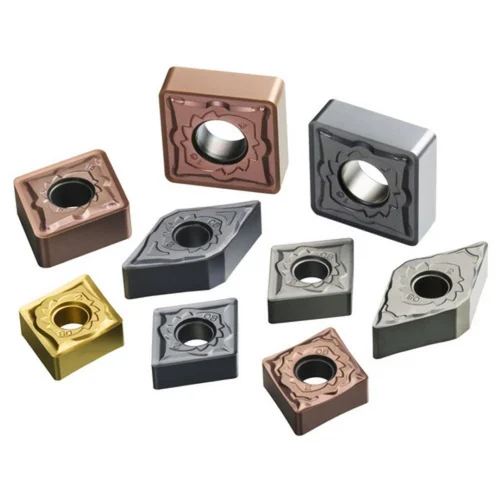
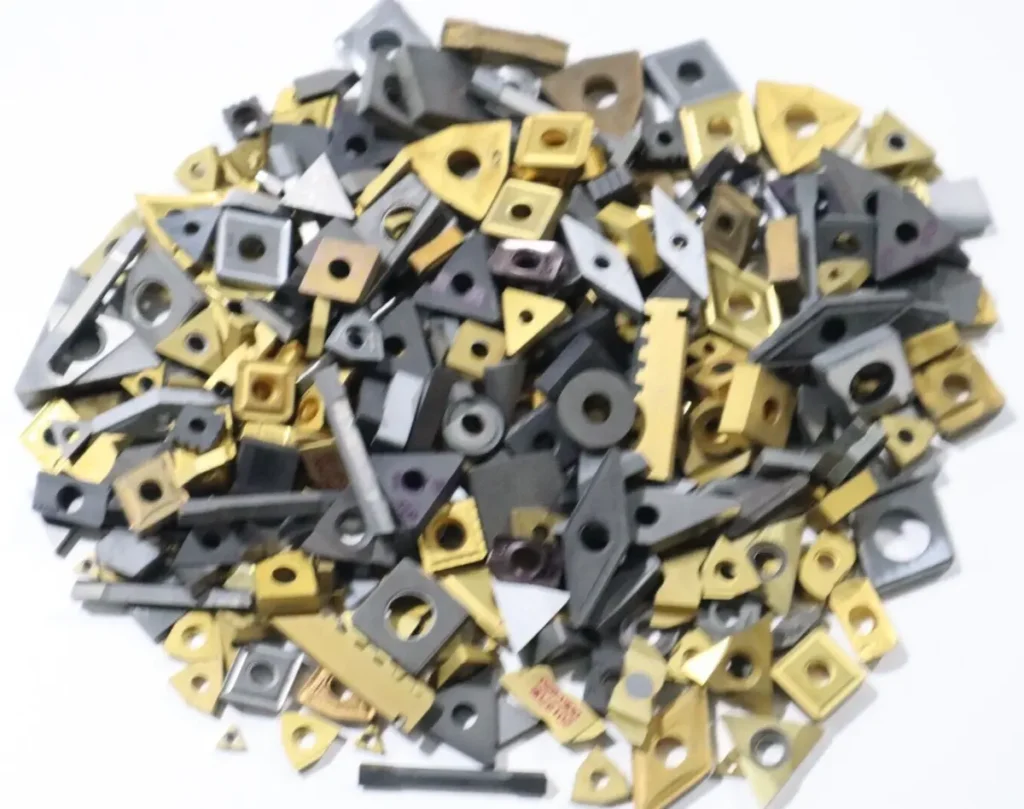


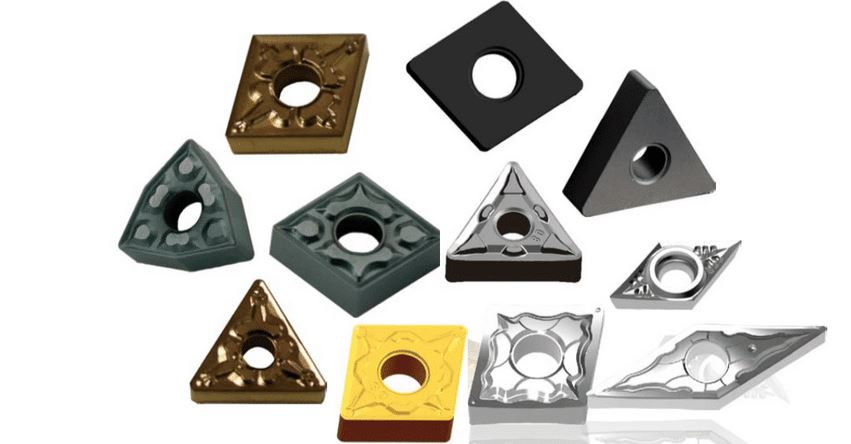
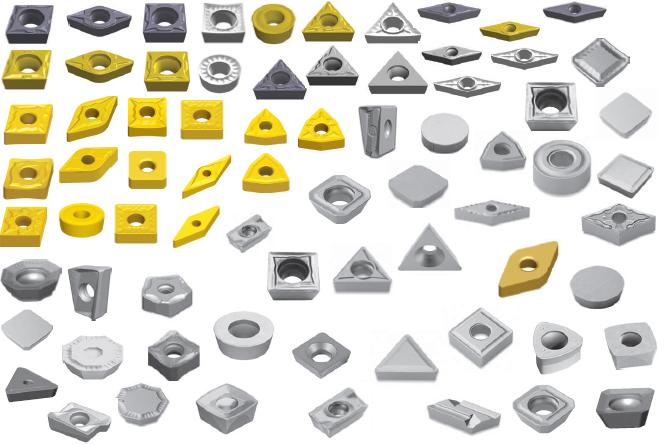
Composition des plaquettes en carbure polies
C'est la composition des plaquettes en carbure polies qui leur confère leurs propriétés uniques. Examinons les matériaux spécifiques utilisés :
| Composant | Description |
|---|---|
| Carbure de tungstène (WC) | Le composant principal, qui assure la dureté et la résistance à l'usure. |
| Cobalt (Co) | Utilisé comme liant, il ajoute de la résistance et de la solidité. |
| Carbure de titane (TiC) | Améliore la résistance à l'usure et la stabilité thermique. |
| Carbure de tantale (TaC) | Améliore la ténacité et la résistance aux chocs thermiques. |
| Carbure de niobium (NbC) | Ajoute de la dureté et de la résistance à l'usure. |
| Carbure de chrome (CrC) | Augmente la résistance à la corrosion et la dureté. |
| Nickel (Ni) | Il est parfois utilisé comme liant alternatif, ce qui lui confère une certaine solidité. |
| Carbure de vanadium (VC) | Améliore la résistance à l'usure et la solidité. |
| Autres additifs | D'autres éléments peuvent être ajoutés pour adapter les propriétés spécifiques à différentes applications. |
Dureté, solidité et résistance à l'usure des plaquettes en carbure polies
L'une des principales raisons d'utiliser des plaquettes en carbure poli est leur dureté, leur solidité et leur résistance à l'usure exceptionnelles. Voici comment ces propriétés se comparent :
| Propriété | Valeur typique |
|---|---|
| Dureté (HRA) | 85-92 |
| Résistance à la flexion (MPa) | 2000-3000 |
| Résistance à la compression (MPa) | 4000-6000 |
| Résistance à la rupture (MPa-m^1/2) | 6-10 |
| Résistance à l'usure | Extrêmement élevé, avec des taux d'usure nettement inférieurs à ceux d'autres matériaux. |
Spécifications, tailles, formes et normes des plaquettes en carbure poli
Plaquettes en carbure polies sont disponibles dans une grande variété de spécifications, de tailles, de formes et de normes. En voici une description détaillée :
| Spécifications | Description |
|---|---|
| Tailles | Epaisseur de 3 à 30 mm, différentes longueurs et largeurs en fonction de l'application. |
| Formes | Carré, triangulaire, rhomboïde, rectangulaire, rond, cylindrique, diamant, etc. |
| Normes | Les normes ISO, ANSI, DIN et JIS garantissent la compatibilité et la qualité. |
| Revêtements | Disponible avec différents revêtements tels que TiN, TiAlN, AlCrN et DLC pour des performances accrues. |
Fournisseurs et prix des plaquettes en carbure poli
Lorsqu'il s'agit d'acheter des plaquettes en carbure poli, le fait de savoir où acheter et de comprendre les prix peut vous aider à prendre une décision éclairée. Voici un aperçu de quelques fournisseurs et des détails sur les prix :
| Fournisseur | Description | Prix (approx.) |
|---|---|---|
| Sandvik Coromant | Fournisseur de premier plan proposant une large gamme d'inserts. | $10 - $50 par insert |
| Kennametal | Offre des plaquettes en carbure de haute qualité pour diverses applications. | $15 - $60 par insert |
| Iscar | Connu pour ses conceptions innovantes et ses performances élevées. | $20 - $70 par insert |
| Sumitomo Electric | Fournit des inserts fiables et durables pour des utilisations multiples. | $12 - $55 par insert |
| Outils Seco | Offre une gamme complète de plaquettes en carbure. | $18 - $65 par insert |
| Walter AG | Connu pour la précision et la longévité de ses produits. | $22 - $75 par insert |
| Tungaloy | Fournit des inserts de haute performance pour des applications exigeantes. | $14 - $60 par insert |
| Matériaux Mitsubishi | Offre une variété de plaquettes en carbure pour différents besoins d'usinage. | $15 - $65 par insert |
| Korloy | Connu pour ses inserts rentables et durables. | $10 - $50 par insert |
| Ceratizit | Fournit des plaquettes en carbure de première qualité. | $20 - $70 par insert |
Comment sélectionner les plaquettes en carbure polies adéquates ?
Pour choisir les plaquettes en carbure polies adéquates, il faut tenir compte de plusieurs facteurs afin de garantir des performances optimales pour votre application spécifique. Voici un guide pour vous aider à faire le bon choix :
| Facteur | Description |
|---|---|
| Matériau usiné | Le type de matériau (acier, aluminium, titane, etc.) a une incidence considérable sur le choix de l'insert. |
| Opération d'usinage | Le tournage, le fraisage, le perçage, etc., nécessitent chacun un type de plaquette spécifique. |
| Conditions de coupe | La vitesse, la vitesse d'avance et la profondeur de coupe doivent être prises en compte. |
| Géométrie de l'insert | La forme et la taille de l'insert doivent correspondre à l'application. |
| Revêtement | Les inserts revêtus offrent des performances accrues dans des conditions spécifiques. |
| Compatibilité des porte-outils | Assurez-vous que la plaquette est compatible avec le porte-outil utilisé. |
| Coût | Tenez compte de la rentabilité par rapport aux performances et à la durée de vie de l'insert. |
| Marque et fournisseur | Les marques et les fournisseurs réputés offrent souvent une qualité et une fiabilité supérieures. |
Comparaison des avantages et des limites des plaquettes en carbure poli
Comprendre les avantages et les inconvénients des plaquettes en carbure poli peut vous aider à décider s'il s'agit du bon choix pour vos besoins :
| Aspect | Avantages | Limites |
|---|---|---|
| Dureté | Extrêmement dur, il permet une coupe précise et une longue durée de vie de l'outil. | Peut être fragile et susceptible de s'écailler en cas d'utilisation inappropriée. |
| Résistance à l'usure | La résistance supérieure à l'usure réduit le besoin de remplacements fréquents. | Coût initial plus élevé que celui d'autres matériaux. |
| Stabilité thermique | Il se comporte bien à des températures élevées, tout en conservant sa dureté et sa résistance. | Un refroidissement et une lubrification appropriés sont nécessaires pour maximiser les performances. |
| Polyvalence | Convient à une large gamme de matériaux et d'applications. | Peut nécessiter des revêtements ou des traitements spécifiques pour une performance optimale dans certaines conditions. |
| Rétention des bords | Maintient une arête tranchante plus longtemps, améliorant ainsi l'efficacité de l'usinage. | Edge peut se dégrader rapidement s'il est utilisé de manière incorrecte ou sur des matériaux inadaptés. |
| Coût | Rentabilité à long terme grâce à la durabilité et à la réduction des temps d'arrêt. | Coût initial plus élevé que pour d'autres matériaux d'outillage. |
FAQ
| Question | Réponse |
|---|---|
| Qu'est-ce qu'une plaquette en carbure polie ? | Les plaquettes en carbure polies sont des outils de coupe en carbure de tungstène utilisés dans les opérations d'usinage. |
| Pourquoi les plaquettes en carbure sont-elles polies ? | Le polissage réduit le frottement, améliore l'état de surface et augmente la durée de vie des outils. |
| Comment choisir la bonne plaquette carbure ? | Tenez compte du matériau, du type d'opération, des conditions de coupe, de la géométrie de la plaquette et de la compatibilité avec votre porte-outil. |
| Quels sont les avantages de l'utilisation de plaquettes en carbure ? | Dureté élevée, résistance à l'usure, stabilité thermique et longue durée de vie de l'outil. |
| Les plaquettes en carbure peuvent-elles être réutilisées ? | Oui, ils peuvent souvent être réaffûtés et réutilisés, en fonction de l'usure et des dommages. |
| Quels matériaux les plaquettes en carbure peuvent-elles usiner ? | Ils peuvent usiner une large gamme de matériaux, y compris l'acier, l'aluminium, le titane, etc. |
| Comment les plaquettes en carbure sont-elles fabriquées ? | Ils sont fabriqués en frittant de la poudre de carbure de tungstène avec un liant métallique, souvent du cobalt. |
| Existe-t-il différentes qualités de plaquettes en carbure ? | Oui, il existe différentes qualités pour différentes applications et différents matériaux. |
| Quelle est la durée de vie typique d'une plaquette en carbure ? | Cela varie en fonction de l'utilisation, mais ils durent généralement plus longtemps que d'autres matériaux d'outillage en raison de leur durabilité. |
| Comment les plaquettes en carbure doivent-elles être stockées ? | Conservez-les dans un endroit sec et frais pour éviter la rouille et la corrosion, de préférence dans leur emballage d'origine. |
Conclusion
Plaquettes en carbure polies sont des outils indispensables à l'usinage moderne, car ils offrent une dureté, une résistance à l'usure et une polyvalence inégalées. Que vous travailliez dans l'industrie automobile, aérospatiale ou médicale, ces plaquettes jouent un rôle crucial en termes de précision et d'efficacité. En comprenant leurs types, leurs applications, les propriétés des matériaux et la manière de les sélectionner, vous pouvez améliorer considérablement vos opérations d'usinage. N'oubliez pas de toujours prendre en compte les exigences spécifiques de votre application et de consulter des fournisseurs réputés pour vous assurer d'obtenir les meilleures performances de vos plaquettes en carbure poli.




